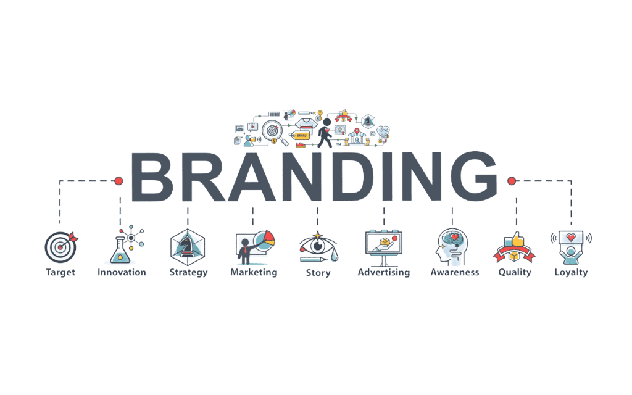
Introduction
Branding is a continuous process through which a strong branding converts your positioning into assets and actions that project it into the minds of your stakeholders, gradually increasing that perception. The perception of your brand in someone’s mind is referred to as reputation. A client’s reputation is developed not only by the client, but also by the stakeholders, which includes potential clients, current customers, workers, shareholders, and business partners.
Strong branding allows a company to stand out from its competition and cultivate a devoted consumer base. If you need to rebrand, you must update your logo and aesthetic across all platforms, both online and offline to establish a consistent brand so that your customers can appreciate your omni-channel presence.
Why is branding important?
The biggest benefit of having a distinct brand is that it has a significant impact on your bottom line, giving you an advantage over your competition. In the world of eCommerce, where new businesses pop up every day, a well-established brand may be a great asset in terms of retaining clients and creating revenues.
Marketing is tactical, but branding is strategic. You can start constructing a marketing plan oriented toward accomplishing those goals once you’ve established the higher objectives and clearly defines your brand promise. Your brand should be designed to accurately reflect who you are as a company and how you want to be perceived.
How branding can be done

To establish and shape a brand, businesses typically employ a variety of tools and some of the methods include:
- Definition of a brand
- Statement of brand positioning
- Identity of a company
- Advertising and public relations
- Partnerships and sponsorships
- Design of products and packaging
- Experience in the workplace and management style
- Customer service is important.
- Strategy for Pricing
- Design of the packaging
Important factors to be focused on while creating a brand

1. Determine who you want to reach
Your brand will not achieve exposure, recognition, trust, or income if it does not resonate with your target demographic. That’s where market research for target markets comes in.
2. Create a mission statement
You must be able to convey the goal of your business so that every aspect of your brand reflects your mission and vision before you can create a brand that your audience recognizes, values, and trusts.
3. Identify your distinct values, qualities, and advantages
Make sure that your brand is made up of inspired components that are completely yours that distinguish your business. Also, make a list of what distinguishes your company from the competition referring to how your products or services improve people’s lives and help them succeed.
4. Produce visual assets
Build a set of brand rules to control the composition and use of your visual assets as you generate the aspects. This will ensure that your new branding is applied consistently and accurately.
5. Discover your brand’s personality
Your target market’s communication style is also considered part of your branding. You need to establish a brand voice that connects and resonates with your target audience otherwise, they will most likely ignore you.
6. Put your brand to work
Once you’ve finished designing and creating your new brand (or rebranding), make sure to incorporate it into every aspect of your company. Pay special attention whenever your company interacts with clients. Here are some guidelines for implementing your brand throughout your company:
Website
Your logo, color palette, and font should be used throughout your website. In your brand standards, only use the assets you’ve already established. Your website is an important component of your company’s identity; if it doesn’t reflect your brand, customers will be confused. Also, make sure that your brand voice is reflected in all site copy, calls to action, and product descriptions.
Use of social media
Make your brand get reflected in all profile images and cover art to make it easier for customers to recognize you. Also ensure that all your profile information, posts, and captions represent your brand voice.
Packaging
If you sell physical goods, your product is most often the most visible way for customers to interact with your brand. As a result, the design, colors, size, and feel of your package should all represent your new branding.
Advertising
Advertisements are frequently used to raise brand recognition and introduce customers to your company, it’s vital that they match your corporate identity. In reality, your branding should make the ad development process easier with a brand style guide.
Customer service and sales
A brand is only as strong as the people who create it, so tell your sales and customer support reps about your brand principles and tell them to follow them, especially when dealing with customers directly. Encourage them to incorporate your logo, tagline, graphics, and brand voice while delivering a branded product demo or addressing customer support questions.
Basics of branding
Brand recognition
The general target audience’s awareness of your brand is referred to as brand awareness. Brands that have a high level of brand awareness are described as “trending,” “buzzworthy,” or “popular.” Consumers can’t contemplate purchasing from your brand if they aren’t aware of it so make your brand strong to establish your company’s identity.
Expansion of the brand
When a company “extends” its brand to generate new products in new industries and markets, this is known as brand extension. Companies (or individuals) can use brand extensions to increase revenue streams and extend the product lines by leveraging brand awareness and equity by which more money is brought in by strong branding.
Identity of a company
Your company’s personality and the promise you convey to your customers are referred to as brand identity. It’s the impression you want your customers to have after interacting with your brand. So make your branding more than just marketing.
Management of a brand
The process of building and sustaining your brand is referred to as brand management. It entails both the tangible and intangible of your brand whether it is a living, breathing asset that needs to be handled accordingly. Consistent branding necessitates regular maintenance.
Recognized brand
The ability of a consumer to recognize and identify your brand without seeing your company name through your logo, tagline, packaging, or advertising is known as brand recognition. This idea is related to brand recall, which is the ability to recall a brand without any visual or audible cues. Strong branding maintains your company at the forefront of people’s minds.
Trust in a brand
Only 25% of people in the globe have confidence in large organizations, brand trust refers to how strongly customers believe in your brand. Customers will trust you if you have a strong brand.
Value of a brand
Consumer perception, recognition, and trust are used to determine the commercial value of your brand. This idea goes hand in hand with the concept of brand equity which enhances the value of your company.
Functionalities of branding
Branding increases business value
When it comes to generating future business, a well-established brand can boost a company’s value by providing it with greater clout in the industry. The end result of the branding process is the brand, which includes the accompanying reputation and value. A strong brand equates to a good reputation, which translates to money. Because it increases a company’s overall value, the brand is a business asset with monetary value in and of itself, and therefore requires its own line item on the balance sheet.
Branding generates new customers
A Strong branding often indicates that customers have a favorable view of the company, and they are more likely to conduct business with you due to the familiarity and assumed dependability of utilizing a name they recognize.
If the brand has a good reputation, possible new customers may come into contact with it and form a positive association with it, making them more likely to buy from it rather than the competition.
Improves employee pride and satisfaction
When a person works for a company that has a strong brand and sincerely believes in it, they will be happier in their job and like the work they do more. Working for a respectable company that is well-liked by the general public makes work more enjoyable and rewarding. Customers and employees are both stakeholders in a brand, as previously noted.
Creates a sense of trust in the marketplace
The level of trust that clients have in a brand influences its reputation in the end. The more trust you have in a brand, the better your opinion of it will be, and the brand’s reputation will improve as a result.
It is the process of determining the best way for a firm to earn and maintain a specific degree of trust among its stakeholders.
Branding in practice
The subject of branding is far from a one-pager that encompasses a wide range of disciplines, including corporate management, marketing, advertising, design, psychology, and others. Different layers of branding exist, each with its own meaning and structure.
Branding Tips for Small Business
Prioritize consistency
Consistency is a priority for recognizable, valuable businesses, and it pays off. Customers may quickly get familiar with, identify, and favor your brand when it has a consistent presence across mediums and platforms. This effort can benefit from brand standards.
Build and follow a brand strategy
A brand strategy is more than just a set of guidelines; it’s a blueprint for achieving particular, long-term objectives as your company grows. The objective of your brand, emotion, flexibility, competitive awareness and employee involvement are all common aims.
Don’t let inspiration turn into imitation
It is critical to conduct a competitive analysis which not only informs you about where your competitors stand and how they are succeeding but may also provide you with suggestions for how to develop or differentiate your brand. However, limit your competitor research and concentrate on what your company has to offer.
Use branding to hire
Your staff will be proud of you if you have a strong brand. So make the most of your brand to recruit talented employees. Employer branding is the process of promoting your organization to potential employees and current employees. That is how the most successful brands set themselves out from the competition.
How to establish a strong brand in eCommerce
Branding is a complex process that requires careful planning and a calculated approach with a branding strategy before launching your online store that resonates well with the targeted customers. Here are the key steps in eCommerce branding:
- Understand your customers through effective communication, and focus on identifying and harnessing the variables that affect your target customers.
- Create a brand persona for your company and use it to deliver consumer experiences. The information you obtain about your target clients has a significant impact on this.
- Since 66 percent of consumers consider transparency to be one of a brand’s most appealing features, make your brand promise crystal clear.
- Online buyers don’t have a chance to touch and feel the products they buy, so make the visual assets extremely perfect.
- Improve your customer experience by ensuring that every encounter and touchpoint with your customers is consistent with your brand promise and adheres to your brand guidelines.
- To create long-term relationships with your customers and humanize your business, operate unique loyalty programs or promotions, offer periodic free presents, or extend discounts.
Branding is the process of building and shaping a brand in the eyes of consumers and the goal is to attract and maintain loyal customers and other stakeholders by consistently delivering a product that meets the brand’s promises.
Conclusion
A product is what you sell, a brand is how people perceive your product, and branding is how you establish that image.
If you’re seeking for a firm to help you establish your brand as a global standard, you can get help from our specialists by contacting us at info@instiqa.com.
